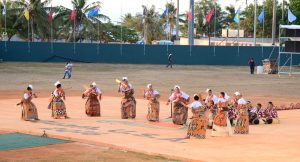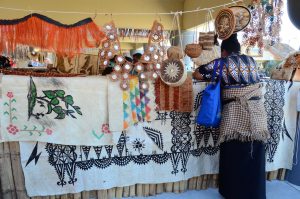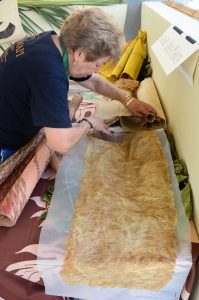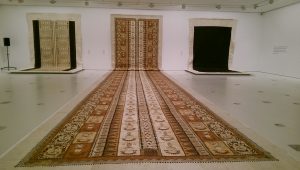Reaching across the Ocean
Posted on July 28, 2016 in Uncategorized
Pacific Presences Visiting Research Fellow Anna-Karina Hermkens writes about her work on barkcloth for the project in relation to the recent Festival of Pacific Arts, held in Guam (22 May-3 June), and an extraordinary exhibition of reinterpreted Tongan barkcloth at the National Gallery of Victoria, Australia (10 June-11 September 2016). My research project for the Pacific Presences Project aims to describe and compare barkcloth (tapa) collected in ‘Melanesia’ and ‘Polynesia’ in the collection of the Museum of Archaeology and Anthropology, detail and analyse its particular colonial representations, and relate these to current performances and discussions in Oceania about making barkcloth cultural heritage.
As part of this project, I was fortunate to be able to attend the Festival of Pacific Arts, held in Guam (Mariana Islands). The Festival of Pacific Arts, also called FESTPAC, is a travelling festival hosted every four years by a different country in the Pacific. The Festival was envisaged by the Conference of the South Pacific Commission (now the Secretariat of the Pacific Community, SPC) in an attempt to combat the erosion of traditional customary practices. Since 1972, delegations from 27 Pacific Island Nations and Territories have come together to share and exchange their cultures at each Pacific Arts Festival. The Festival “is recognized as a major regional cultural event, and is the largest gathering in which Pacific peoples unite to enhance their respect and appreciation of one another”.[i]
In Guam, which was the 12th country to host the festival, around 2,500 performers, artists and cultural practitioners showed their skills in canoe-faring, performed dances, music and poems, showcased their films and artworks, and sold and demonstrated ‘traditional’ arts and crafts, including barkcloth.

The Tongan delegation performing at FESTPAC, wearing layers of ngatu (barkcloth).

The pavilion of the Tongan delegation at FESTPAC with fine mats and ngatu.
Barkcloth, often referred to as tapa, but known as ngatu in Tonga, masi in Fiji and kapa in Hawaii, amongst others, is known and used across Oceania. In many Pacific Islands, people have been making barkcloth from the paper mulberry tree, but it is also being made from the inner-bark of Ficus trees. The cloths, which vary from small strips of loincloth to more than twenty metres-long pieces of cloth, are intimately interwoven with past and present socialities across Oceania. They have been used to decorate, wrap, cover, protect and carry the human body, as exchange valuables and commodities, in land claims, and as indexes and embodiments of ancestral power. It therefore comes to no surprise that tapa was very much part of the Festival of the Pacific Arts. Not only was it worn by many delegates during their dance performances, it was also sold as both raw material and decorated cloth, as framed paintings and as sculptures. Among those buying tapa were not just tourists and festival visitors. Pacific delegates exchanged pieces with each other and bought each others work. For example, Rapanui delegates, who value tapa immensely as it is part of their ‘lost’ cultural heritage which they try to reclaim, but also because mulberry trees are scarce on Rapanui, bought large pieces of undecorated white tapa from Tongan delegates, as well as a large piece of decorated Fijian tapa.
For the Samoan, Fijian, Tongan and Rapanui tapa makers I spoke with during the Festival, tapa is about their culture. As Fijian Talei Manara stated, “everything we do, we must wear masi (tapa)!” But it is also seen as something that connects Pacific Island societies with each other and the wider world. “Masi will send you around the world”, said masi maker Selai Buasala, who teaches her daughters how to make and design (paint) masi, just as her mother taught her. It opens up different pathways, enabling Pacific islanders, and especially local women, to travel in order to promote and sell their tapa work. But essentially, it is “about our place in the world”, as Moana Eisele from Hawaii expressed, about what it means to be Hawaiian, Tongan, Samoan, or Fijian.

Moana Eisele making Hawaiian kapa (tapa).
This capacity of barkcloth to reach out and at the same time create regional and local belongings and identity, has been taken up and pushed further by New Zealand-Aotearoa based printmaker and painter Robin White and Tongan artist Ruha Fifita in their collaborative project ‘Siu I Moana: Reaching Across the Ocean’, which is on display in the National Gallery of Victoria in Melbourne (Australia). In their vision, their collaborative series of re-interpreted Tongan barkcloth (ngatu) form a pathway, not only for Pacific Islanders, but also for humanity at large to come together and create connections. Importantly, White and Fifita’s project is part of the largest exhibition of contemporary Pacific art ever to be held in Australia this far. Stereotypically being classified as craft instead of art, Pacific arts such as painted barkcloth have predominantly been displayed in ethnographic museums. And while receiving recognition for their work in New Zealand and Europe, Pacific artists and their work have been structurally underrepresented in the Australian museum context. As such, White and Fifita’s ngatu has already proved to be a pathway for both Pacific arts and artists to enter the Australian gallery and art market and to finally receive recognition by one of Australia’s leading national galleries.
White’s and Fifita’s choice for barkcloth as their medium comes perhaps as no surprise as it is inherently part of Ruha’s Tongan ‘roots’ and referred to by White as “the DNA of the Pacific”. White and Ruha have imbued Tongan ngatu, which is traditionally used as ceremonial gift in weddings and funerals, as garment, and part of royal inaugurations and rituals, not just with artistic skill and significance, but also with new spiritual meaning.

Three of the eight ngatu (painted barkcloth) composed floating in a huge white cube, with the center piece (titled Seen along the avenue) stretching out towards the entrance, inviting the audience to enter the room and follow the halakafa – at once a pathway and, traditionally, a place for tying rope ‒ that runs through the middle of the ngatu and which leads to the sacred and the spiritual (Mt Carmel).
For White and Fifita, the collaborative creative process of working with the earthly materiality, timbre and temporality of barkcloth and traditional dyes, engendered a sense of wholeness. This wholeness has, as they hope, not only fulfilled themselves, but also imbued their ngatu with a significance that transcends the mere artistic. The layers of soft white ngatu, painstakingly painted with both old and new metaphorical and symbolic designs, are envisioned to wrap and bring people together, regardless of gender, age and ethnicity.[i] Siu I Moana is therefore indeed reaching across the Ocean, just like the Festival of Pacific Arts does. It connects people in the Pacific (Tonga and New Zealand) and in the Australian Pacific diaspora, but it also reaches out to all of humanity in the hope of engendering uplifting experiences of community, hope and renewal.[ii]
I hope that my project for the Pacific Presences Project generates similar forms of connectedness by connecting historical museum collections with present-day tapa makers, creating new understandings and valuations of tapa past and present.
[i] Ryan, Judith 2016. ‘Siu i Moana: Reaching across the Ocean.’ Essay. https://www.ngv.vic.gov.au/essay/siu-i-moana-reaching-across-the-ocean/
[ii] Interview with Robin White and Ruha Fifita, Melbourne 12 June 2016.
[i] https://festpac.visitguam.com/visiting-the-festival/about-the-festival
Anna-Karina Hermkens 2016
